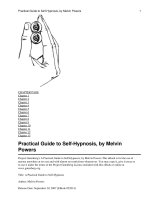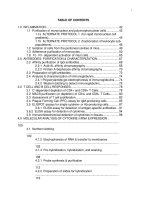A Practical Guide to Shaft Alignment phần 6 pdf
Bạn đang xem bản rút gọn của tài liệu. Xem và tải ngay bản đầy đủ của tài liệu tại đây (3.11 MB, 13 trang )
51
Laser shaft alignment
To be able to measure an offset a system detector range has to be twice
the offset. As with a dial gauge, the laser receiver measures twice the
physical offset of the two shafts as shown below.
To measure a physical offset of 80 mils we need a detector
measurement range of 160 mils.
© 2002 PRUFTECHNIK LTD.
52
Laser shaft alignment - Case study
Laser Shaft Alignment Cuts Energy Costs
A project to determine the extent to which shaft misalignment inuenced
the power consumption of the plant was set up as a graduate student
project at a major UK chemical processing plant. The study was
conducted over a six week period in a controlled environment that
accurately reected the normal operating conditions across the plant.
A redundant 7.5 kW pump rig in a plant was used for the investigation.
Before the project commenced the pump and motor were removed to
the workshop where new bearings were tted, and both units were
rebalanced to eliminate any external factor that could distort the project
results. Plates and jacking bolts were attached to the motor base plate
to allow ne adjustments in alignment condition. The pump set was
installed to circulate water through a closed loop of piping with the
motor running at 3000 RPM (+/- 1% due to variations in load condition).
The pump and motor were initially installed with the alignment recorded
as 0.00 gap and offset in the vertical and horizontal directions. The
system was run in this condition for a number of days with current drawn
being measured at the distribution board every few hours. During the
course of the trial period the alignment of the machines was adjusted
and at each misalignment interval run for a set period with current
drawn measured at regular intervals.
Across the site the two principle types of coupling installed were “pin”
and “tire” couplings. In order to obtain a reasonable picture of potential
savings that could be obtained in the plant both types of coupling were
installed with the same amount of misalignment/current measured on
each coupling type.
The results of the study are shown in the following graphs. Offset
misalignment affected power consumption more than angularity;
angular misalignment affected power drawn by “pin” type couplings
more than “tire” couplings. The components of misalignment are
additive irrespective of whether the misalignment was vertical or
horizontal.
© 2002 PRUFTECHNIK LTD.
53
Laser shaft alignment - Case study
© 2002 PRUFTECHNIK LTD.
54
Laser shaft alignment - Case study
It was concluded from the project to implement a site wide recommenda-
tion to align machines to within an offset tolerance of 0.005 inches and
an angularity tolerance of 0.0005 inches per inch of coupling diameter.
To estimate the potential cost savings that could accrue from this new
site standard a random sample of machines were measured to estimate
the extent of misalignment that existed on the plant. The pie chart below
illustrates the ndings of this survey.
Shaft offsets in 1/100 mm at the coupling center for a sample of 100
machines operating at 3000 RPM.
© 2002 PRUFTECHNIK LTD.
55
Less than 10% of machines measured were within the recommended
site alignment standard.
Using the pie chart a representative median offset of 0.35 mm was
estimated as a reasonable gure for calculating the potential power
saving in the plant. Given that the power consumption for the rotating
equipment in the plant was in the range of 30 Megawatts, the following
estimate of power saving that could be achieved was:
Assuming electricity rates of $0.06 per kWh and a conservative %
power reduction of 0.75%.
30,000 kW x 0.75% x $0.06 / kWh = $13.50 per hour
or $101,360. – per year!
Laser shaft alignment - Case study
© 2002 PRUFTECHNIK LTD.
56
Laser shaft alignment - Case study
Laser shaft alignment improves pump reliability
Substantial plant operating improvements were achieved following
the introduction of a comprehensive pump alignment and monitoring
program at a major Acetate Chemical plant in Derbyshire.
The production process requires materials to be mechanically moved
around the plant from process stage to process stage. Some 260
pumps are used in this plant, it is therefore vital that both duty and
stand-by equipment is reliable and available. Maintenance was very
much a reghting exercise until 1996. The plant engineer at that time
persuaded management of the need to take a more pro-active view of
pump performance maintenance and monitoring. Using Prueftechnik
laser alignment systems and condition monitoring equipment a
coordinated plan to improve plant performance was introduced.
In the preceding years there had been an estimated 120 pumps repaired
per year at an annual cost of some $192,000.–, the calculated mean time
between failure (MTBF) of these pumps was 10 months.
By applying a combination of laser alignment of newly refurbished
machines and alignment of installed machines when time permitted
plus routine plant condition monitoring together with a comprehensive
review of installed components such as seals, bearings and gaskets
the plant began to see signicant savings on maintenance of the all
important pump systems.
The program, now well established, has returned substantial dividends.
Plant reliability has improved to more than 46 months MTBF and routine
pump repairs have been drastically reduced.
Calculated savings are now in excess of $157,000.– per year, and since
the beginning of the program in 1996 is in the order of $880,000!
© 2002 PRUFTECHNIK LTD.
57
Laser shaft alignment - Case study
Engineer’s and manager’s commitment to the program
Patience!
Laser Alignment
Condition monitoring
Training
Root cause analysis
Careful mechanical seal selection
Careful bearing selection
Partnerships with suppliers
Improved piping design and installation
Considered pump selection
Advanced lubrication systems selection
A comprehensive plan of action was used by engineers to achieve these
extraordinary savings in the plant, the key factors include:
© 2002 PRUFTECHNIK LTD.
58
Laser shaft alignment - Case study
A study was conducted by the Infraspection Institute in the USA to
evaluate the effect of misalignment on key machine elements such as
bearings, seals and couplings.
In a series of tests, misalignment was introduced into a pump motor
set. At each new misalignment interval thermographic pictures were
taken to identify the degree of temperature rise on key components.
The tests were conducted across a wide variety of exible coupling
types. Without exception all couplings, bearings and machine housings
(and therefore seals) showed signicant temperature rise. The graphic
below shows the effect of misalignment on components when the
machine set was aligned to +/- 2 mils and when the misalignment was
increased to + 20 mils.
Aligned to +/- 2 mils Aligned to + 20 mils
Not only was the exible element of the coupling shown to heat up, but
the machines themselves also develop elevated temperatures particularly
around the bearing housings. Neither bearings nor seals are designed
to operate at the elevated temperatures caused by misalignment for
prolonged periods of time. An inevitable result of their operating in these
conditions is premature failure and reduction in machine operating life.
Laser shaft alignment improves bearing and seal life
© 2002 PRUFTECHNIK LTD.
59
Laser shaft alignment - Case study
Laser shaft alignment reduces vibration alarms
During the period from 1987 to 2000 a major UK petroleum renery
adopted laser shaft alignment as a standard policy for all coupled
rotating machinery. They used the Prueftechnik OPTALIGN system
and later the ROTALIGN
®
system. Over the period they also monitored
the incidents of vibration alarms and how, if at all, the use of laser
shaft alignment would help reduce this. Alarms were broken down
into problems caused by “misalignment” and “other” problems such
as bearing damage, unbalance and mechanical looseness.
The graph provided by the company shows clearly that a substantial
reduction in alarm violations was achieved, with those of alignment
related problems all but eliminated altogether.
© 2002 PRUFTECHNIK LTD.
60
Thermal expansion of machines
In most cases in this handbook, we have considered only the cold
alignment conditions of rotating machines. However, for larger machine
sets and for equipment that operates at elevated temperatures on one
component of the machine set it is necessary to consider the effects of
expansion (or contraction) on the alignment condition of the machine.
There is little point in accurately aligning a machine set at cold if this
alignment condition will change at the normal operating condition of
the machine set. There are a number of ways of establishing the nal
alignment or operating alignment condition.
Manufacturers of machines should be able to provide
thermal offset information
Empirical calculation based on coefcient of Thermal
Expansion for specic materials per unit length of centerline
height per degree of thermal change (see following page).
Online measurement of cold to hot alignment condition
using contact or non contact alignment measurement
instruments.
Estimating or calculating the effective alignment position change is
by no means a simple operation. On complex machine systems such
as compressors where there are a number of machine elements each
with varying temperature gradients simple thermal growth calculations
become very complex. In these cases on-line measurement of the
machine components is usually necessary.
© 2002 PRUFTECHNIK LTD.
61
Thermal expansion of machines
Thermal growth calculations
If the direction and extent of growth are known, the machines
may be purposely misaligned such that they grow into place,
resulting in good alignment condition during normal operation.
OPTALIGN Smart, SHAFTALIGN
®
and ROTALIGN
Ultra
contain a special function designed especially to incorporate
such alignment target values. The most readily available target
specifications for cold alignment are generally obtainable from
machine manufacturers. Where this information is not avaliable the
following calculations will assist in establishing thermal growth.
DL = L (c) (DT)
Where DL = thermal expansion
L = height centerline to base of machine
c = coefcient of thermal expansion of material
(0.0000059” for cast iron)
DT = change in temp from ambient
For example:
A pump with liquid at 300ºF.
Base to center height 26 inches.
Ambient temp 50ºF.
DL = L (a) (DT)
DL = 26 inches (.0000059) x (300-50)
= 26 inches (.0000059) x 250 = .038 inches
(Some advanced laser alignment systems such as ROTALIGN Ultra
perform these calculations for you)
© 2002 PRUFTECHNIK LTD.
62
In these cases, a laser system such as the Prueftechnik PERMALIGN
®
system is an ideal tool. Systems such as PERMALIGN are designed
for long term operation in difcult conditions, often the very act of
mounting the equipment onto a turbine or compressor operating in
excess of 572 degrees F will mean that the measurement system needs
to be cooled to avoid damage or inaccurate thermal growth readings.
Thermal expansion is not however the only cause of machine position
change. Many elements can impinge on the accuracy of the nal result
such as:
Thermal Expansion of bearing supports
Changes in radial or axial forces
Changes in oil lm thickness on bearings
Changes in foundation or base plate supports
Changes in piping forces.
Thermal expansion of machines
© 2002 PRUFTECHNIK LTD.
Distributor for USA, Caribbean & Venezuela:
LUDECA Inc.
1425 N.W. 88
th
Avenue
Doral, FL 33172, USA
Tel (305) 591-8935
Fax (305) 591-1537
www.ludeca.com
All other regions:
PRÜFTECHNIK
Alignment Systems GmbH
Freisinger Str. 34
85737 Ismaning
Germany
Tel +49 89 99616-0
Fax +49 89 99616-100
www.pruftechnik.com
© 2002 PRUFTECHNIK LTD.









